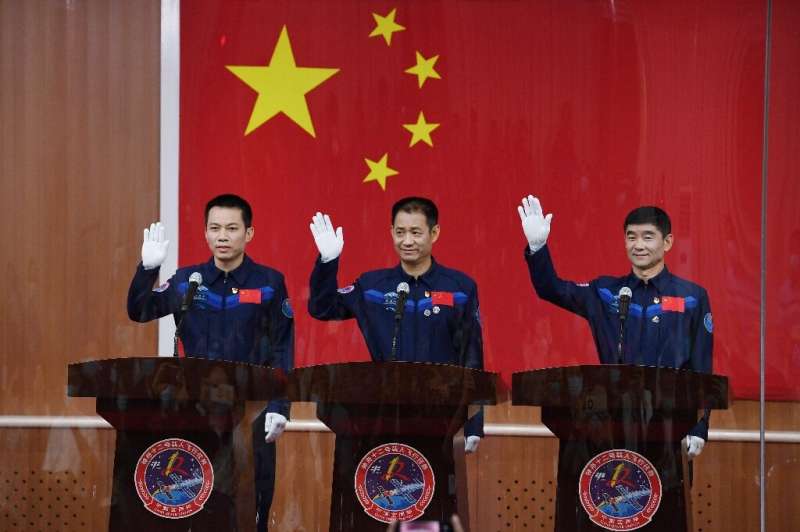On Thursday, June 17th, China took another major step in its ongoing drive to become a superpower in space. Just two months after the core module of the Tiangong space station (literally, “Heavenly Palace”) was sent to orbit, the three astronauts that will be the station’s first crew launched to space. The mission, Shenzhou 12, lifted off atop a Long March-2F rocket at 09:22 p.m. on Wednesday evening local time (09:22 a.m. EDT; 06:22 a.m. PDT) from the Jiuquan launch center in the Gobi desert.
The launch, which was the seventh crewed mission of the Shenzhou spacecraft and the first crewed expedition to the new space station, was broadcast live on the state network CCTV. According to the China Manned Space Engineering Office (CMSEO), the launch was a complete success, with the spacecraft separating from the rocket 573 seconds later and entering orbit to rendezvous the station.
About six and a half hours later, at 3:54 a.m. EDT (12:54 a.m. PDT), the spacecraft successfully docked with the Tianhe core module, and the three astronauts – Nie Haisheng, Liu Boming, and Tang Hongbo – entered the station. As the CMSEO reported shortly thereafter:
“After the Shenzhou-12 manned spaceship successfully completed a fast automated rendezvous and docking with the orbiting space station core module Tianhe, the Shenzhou-12 crew entered the orbital module from the re-entry module. After a series of preparations as programmed, opened the hatch of the core module, and at 18:48 a.m./p.m. (Beijing Time) on June 17, 2021, the astronauts Nie Haisheng, Liu Boming and Tang Hongbo entered the Tianhe module one by one. The crew will carry out relevant work as planned.”
The crew will spend the next three months aboard the Tiangong space station where they will engage in a number of orbital science operations. These will include conducting extravehicular activities (EVA), aka. “spacewalks”, in suits that were delivered by the Tianzhou-2 mission. They will also test the station’s large robotic arm and verify the module’s regenerative life support system.
The Tianhe module (literally “Harmony of the Heavens” in Chinese) provides propulsion, guidance, navigation, and orientation control, along with the station’s power supply and life support systems. It also contains a living quarter for its three crew members that measures 50 m3 (compared to the 15 m for Tiangong-1) with beds, a kitchen and toilet, computers, and equipment to conduct science experiments and communications with the ground.
The design of Tianhe also includes multiple ports to accommodate visiting Shenzhou spacecraft and other modules that will be integrated over time. The module also has two robotic arms, the smaller of which measures 10 m (33 ft) and is intended for exterior station operations. The large robotic arm – aka. “Chinaarm” (like the “Canadarm,” “Canadarm2,” and “Canadarm3“) is similar to the Lyappa arm used on Mir.
It is this arm that will be used to attach future modules to the two ports located at the end of Tianhe’s long axis, gradually scaling up the station and allowing for a more diverse array of science operations. The proposed future modules include two Laboratory Cabin Modules (LCMs) – “Wentian” and “Mengtian” – which will provide additional navigation, avionics, and backup propulsion and orientation control.
The Wentian and Mengtian modules are currently scheduled to launch between May-June and August-September of 2022 (respectively). Once they are integrated and operational, the station’s crews will be able to conduct scientific experiments in a microgravity environment, something that is only possible for a few minutes at a time here on Earth (in simulated microgravity).
Experiments will also be mounted on the outside of the hull to measure the effects of exposure to the space environment, vacuum, cosmic rays, and solar winds. These are similar to the research that is currently conducted aboard the International Space Station (ISS), the purpose of which is to determine how humans will contend with space radiation and microgravity during long-duration missions to deep-space, the Moon, and Mars.
On the morning of Wednesday, June 23rd, the crew spoke to Chinese President Xi Jinping, who addressed them from the Beijing Aerospace Control Center. That same day, the CNSA also uploaded a video that showed what daily operations were like for the crew on the station during the first week (posted below). For the most part, this consisted of preparing for the various operations they will be conducted later.
The Shenzhou 12 mission is the third of eleven launches that will culminate with the construction of the three-module station. As the third and final installment in the Tiangong program, this station is meant to rival the ISS, which is due to expire in 2024 (though it’s possible the mission will be extended until 2028). The program is one of many intended to advance China’s presence in space and its influence abroad.
Further Reading: Phys.org, Space News

